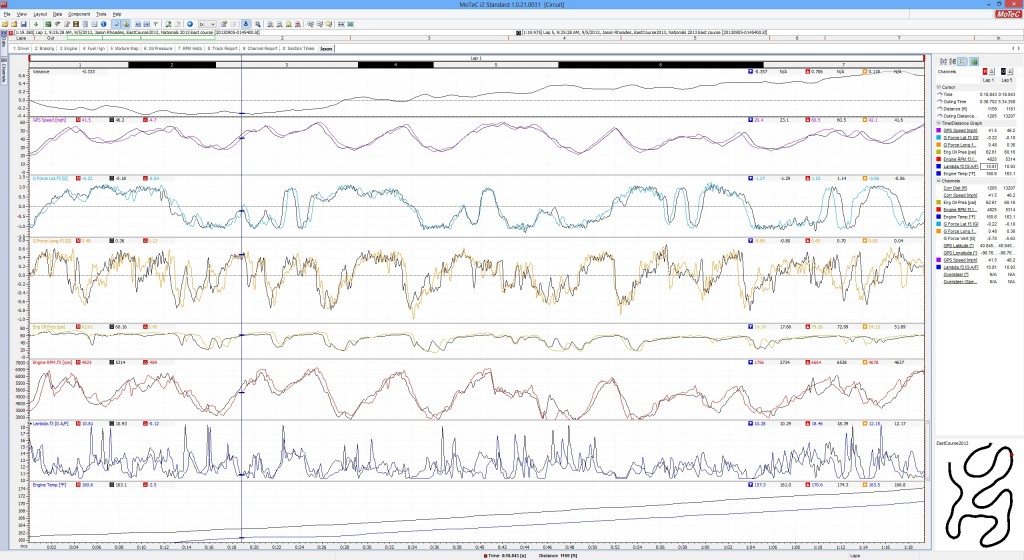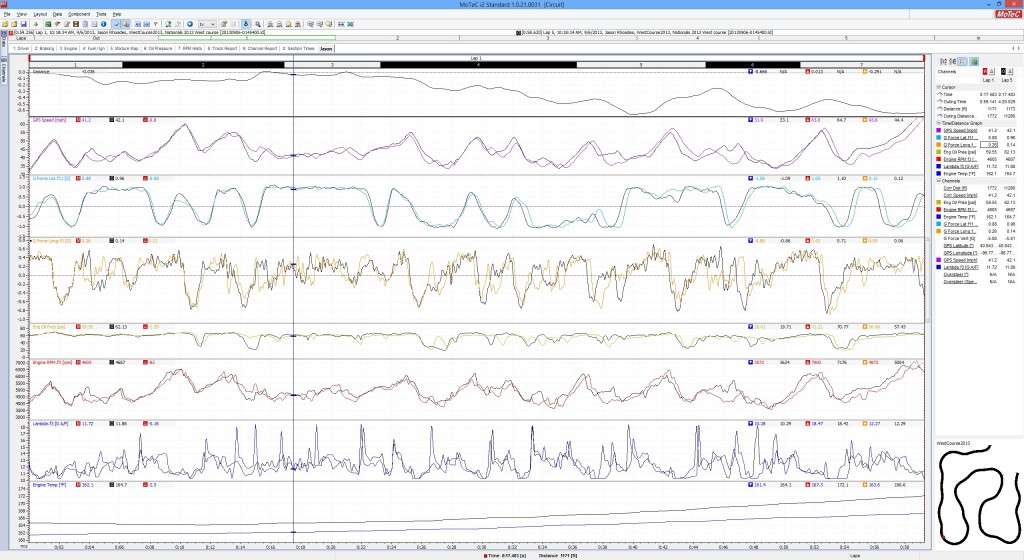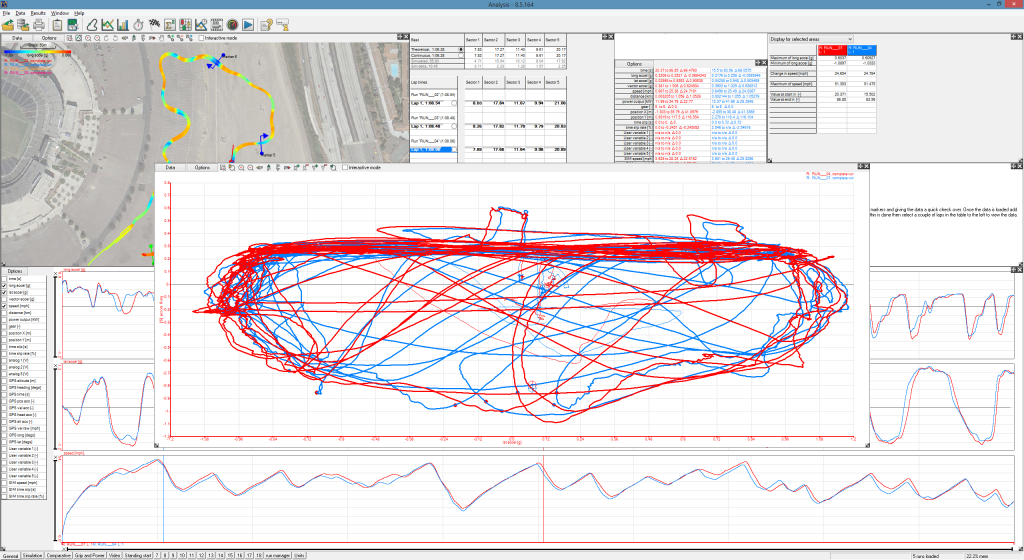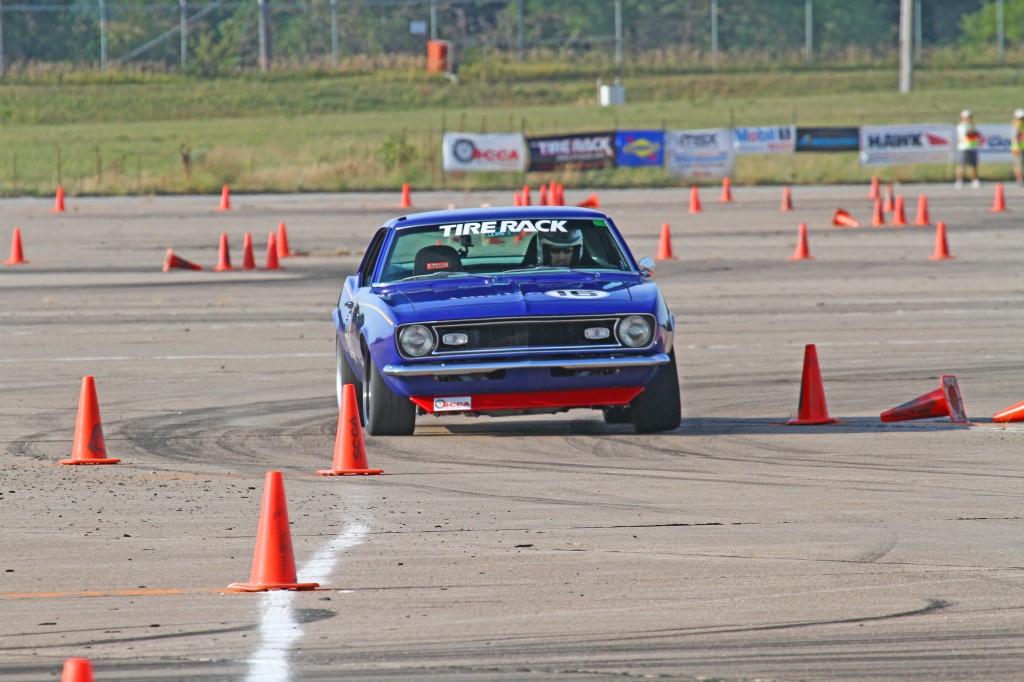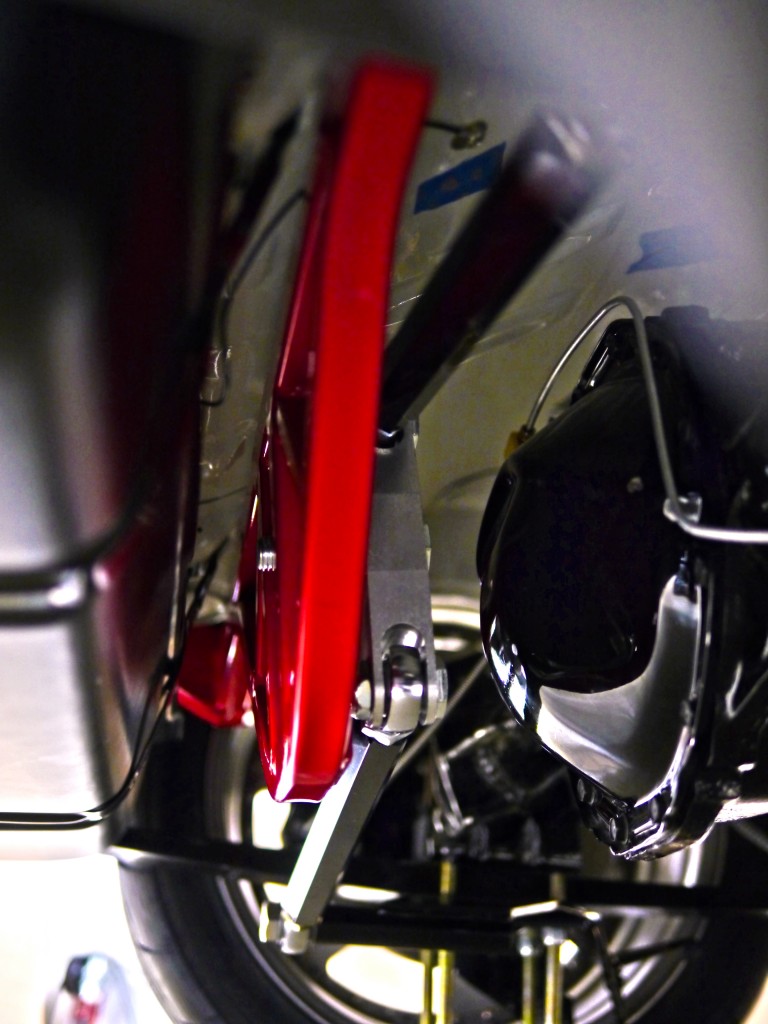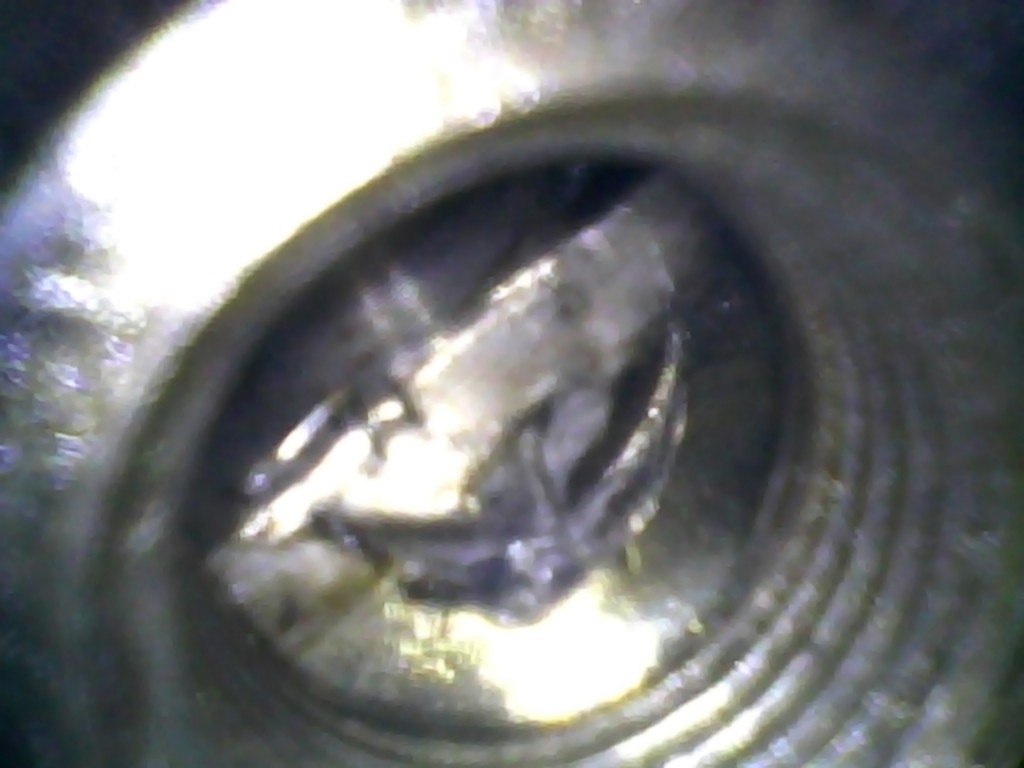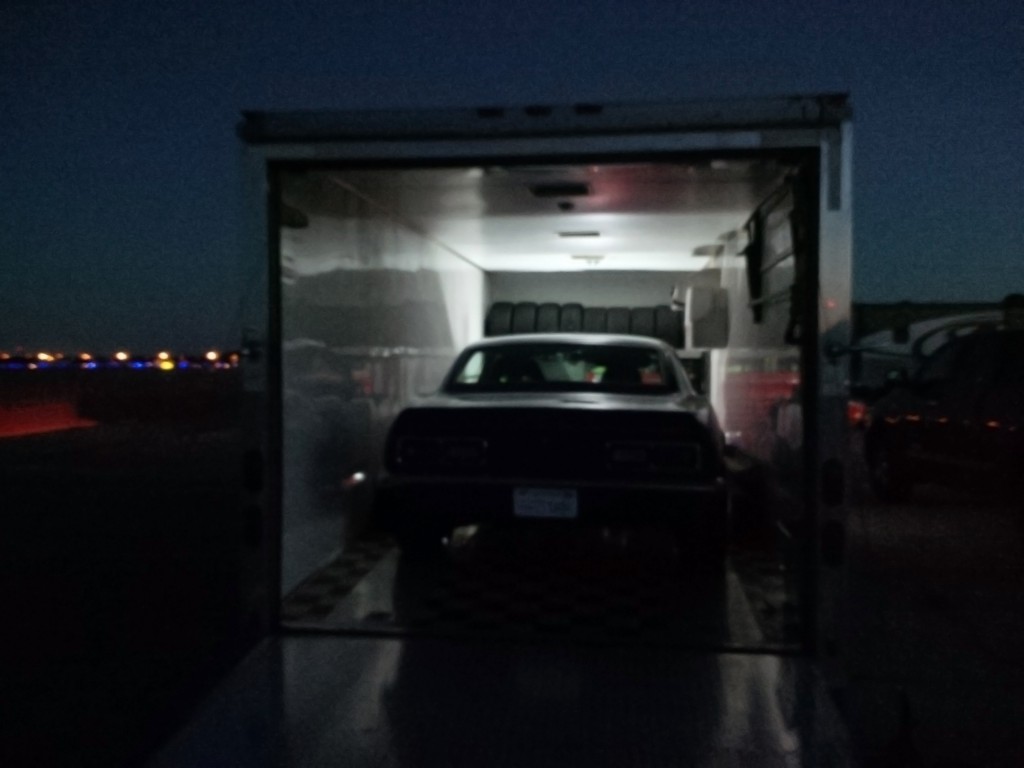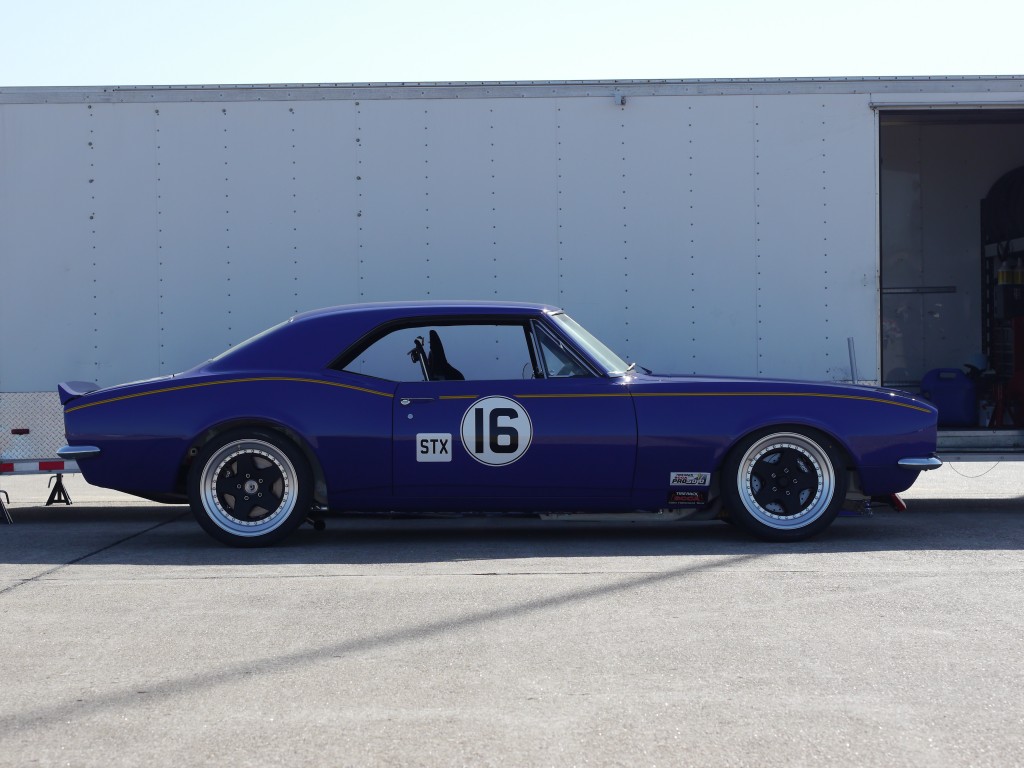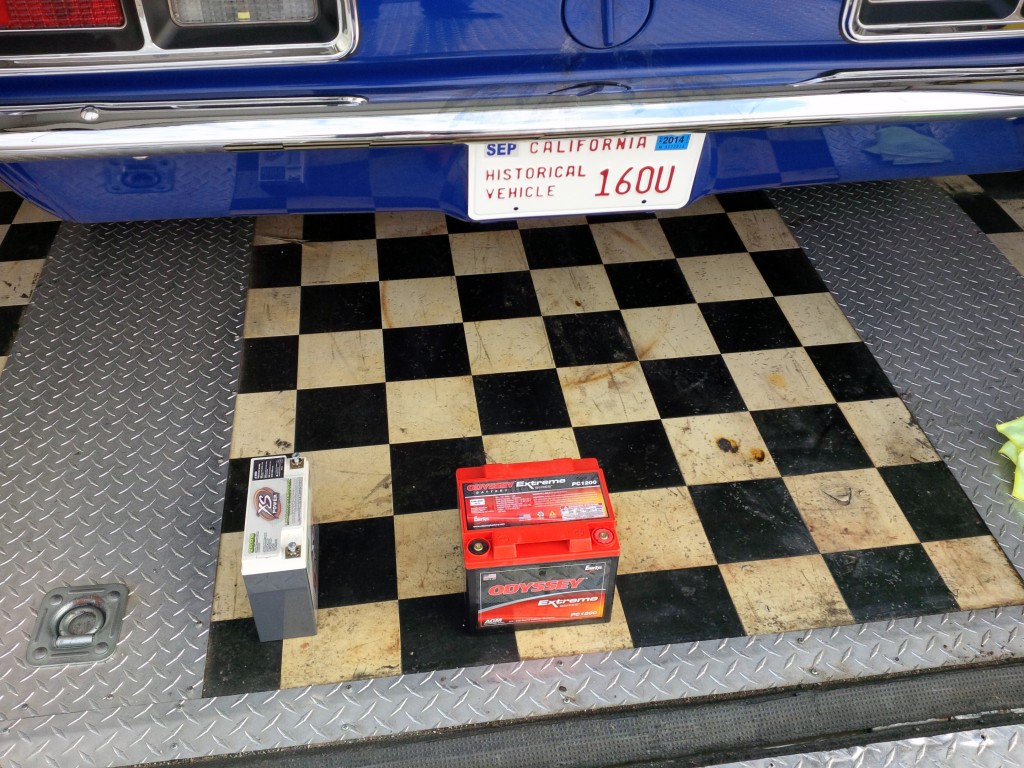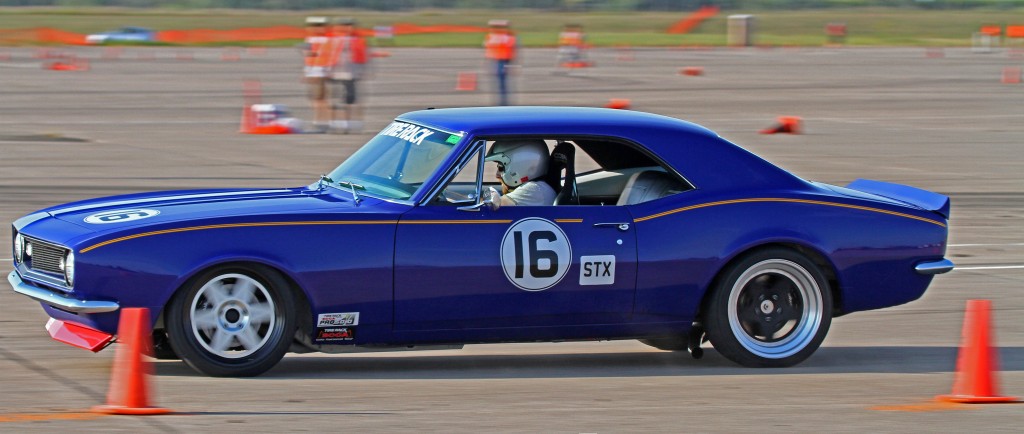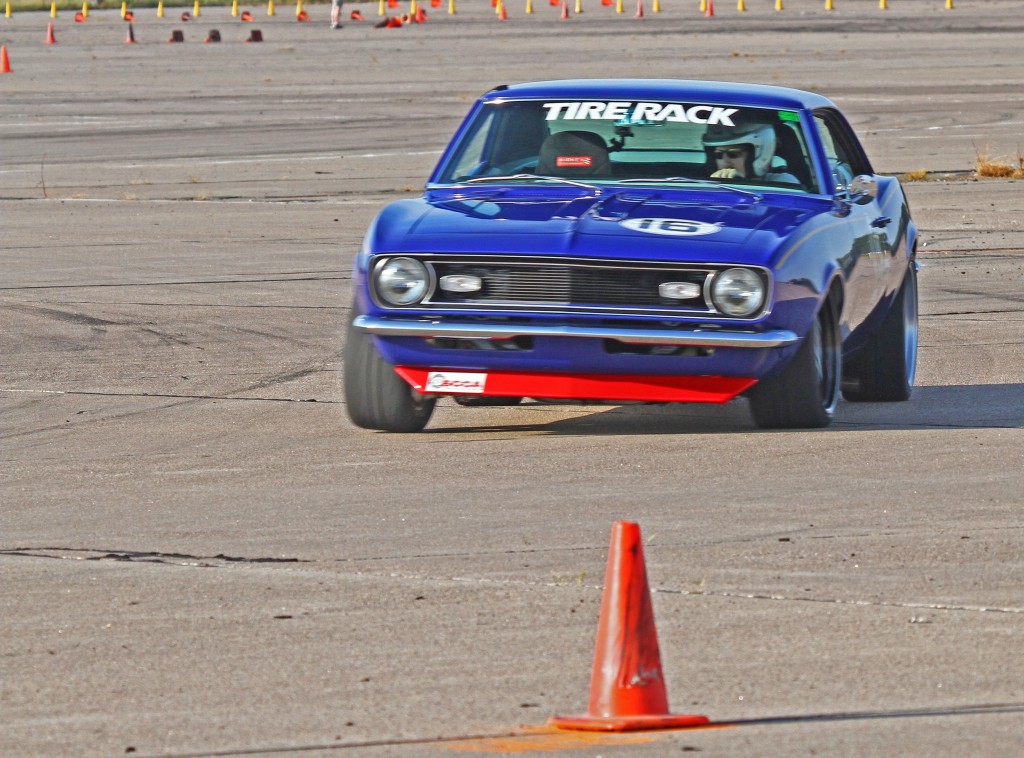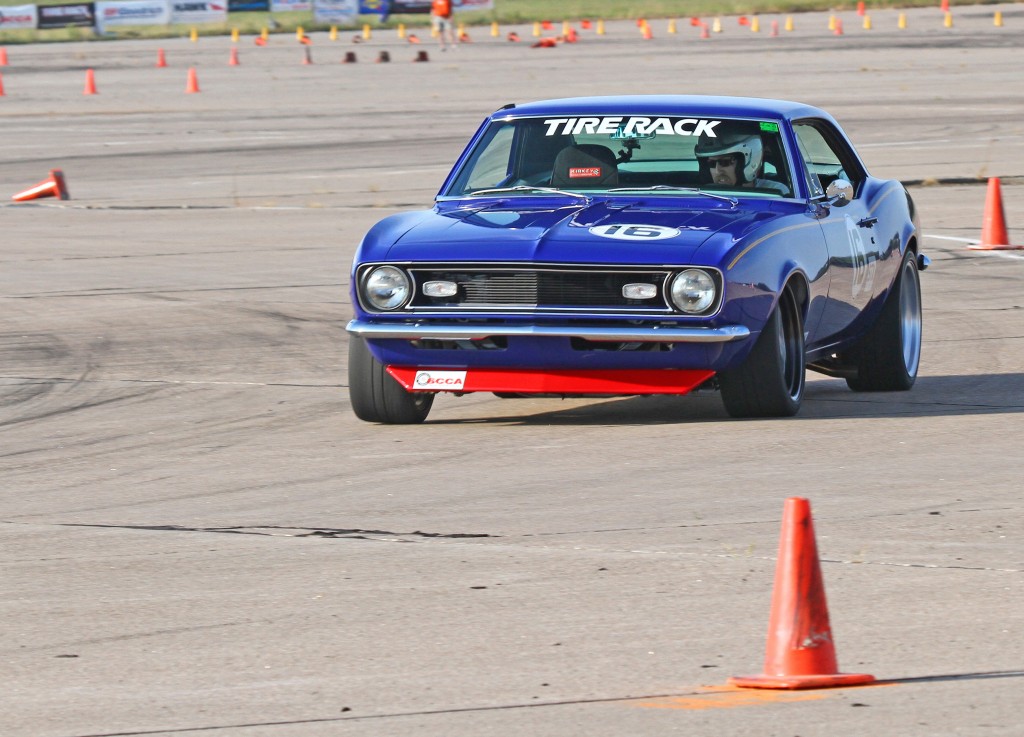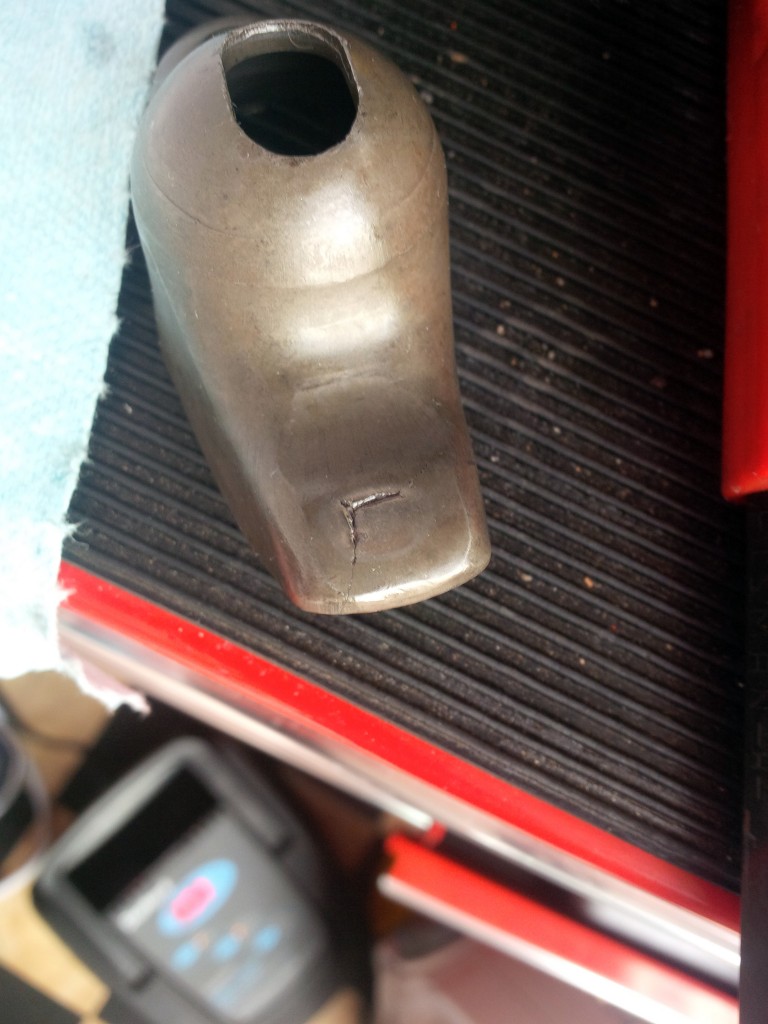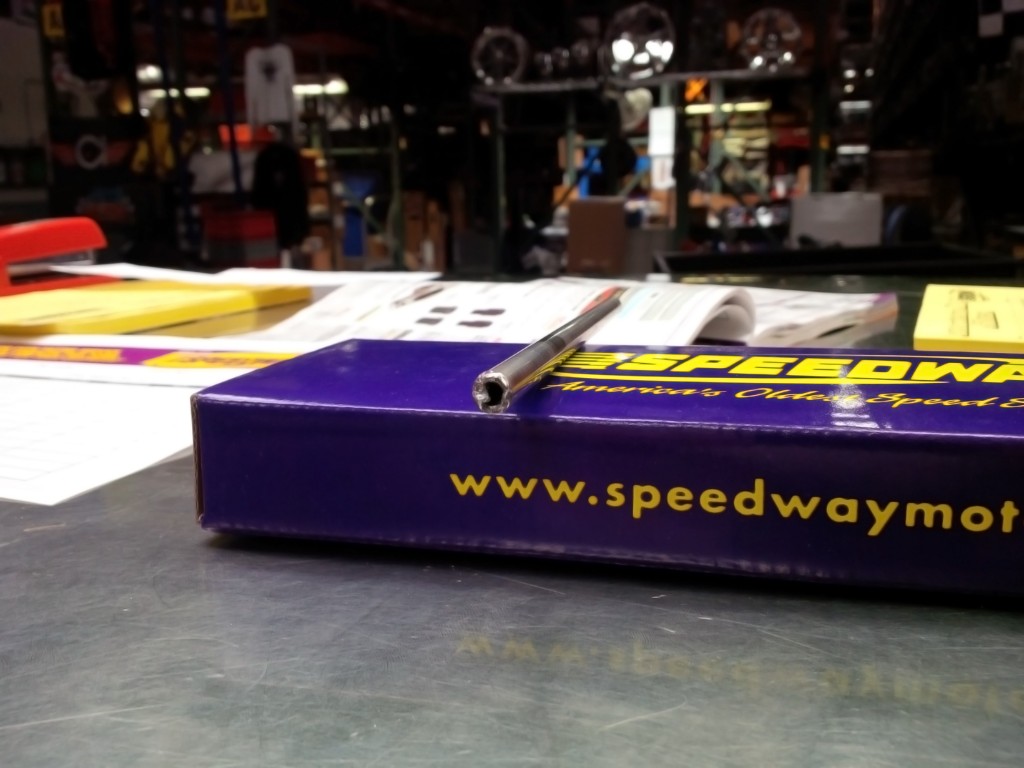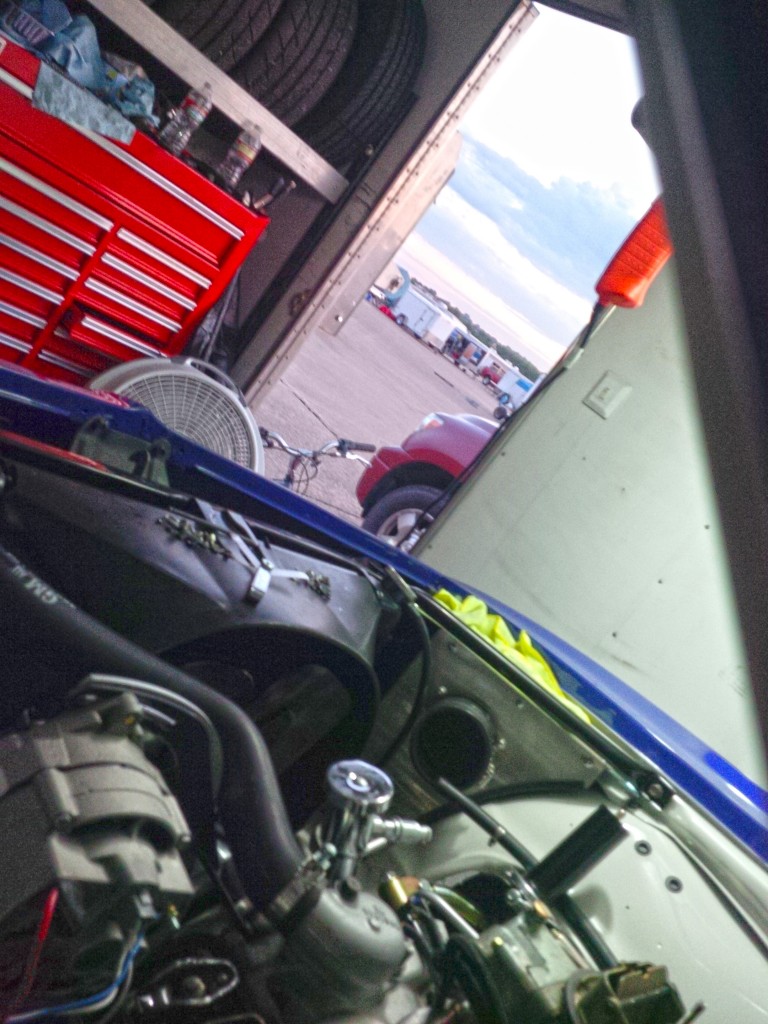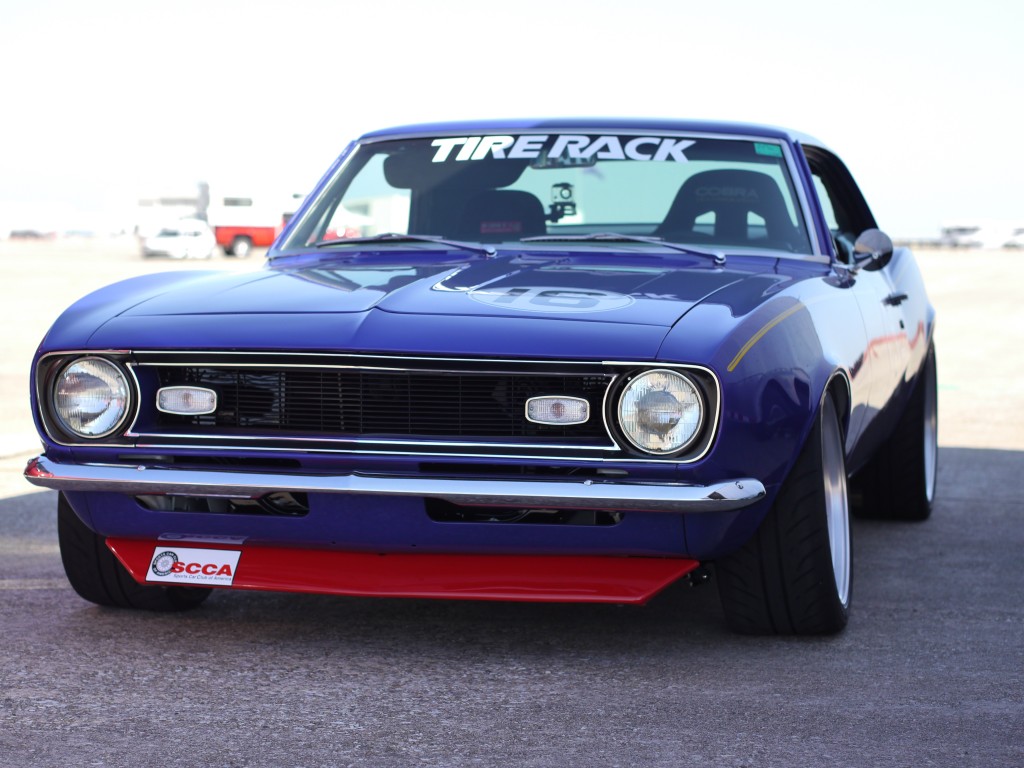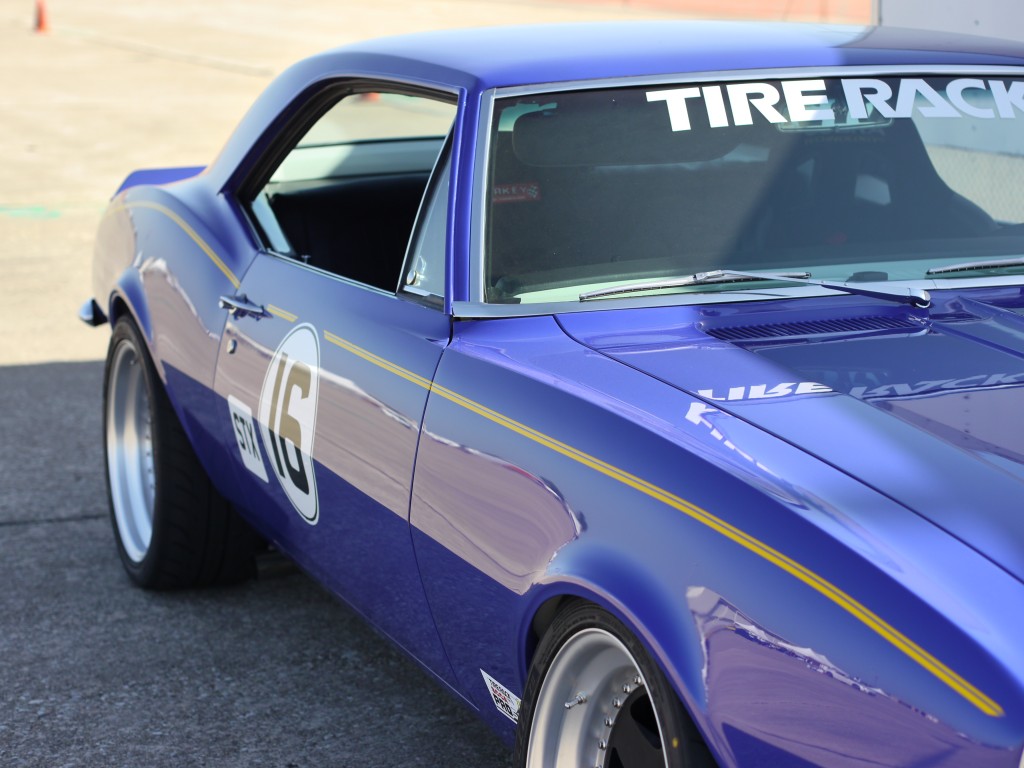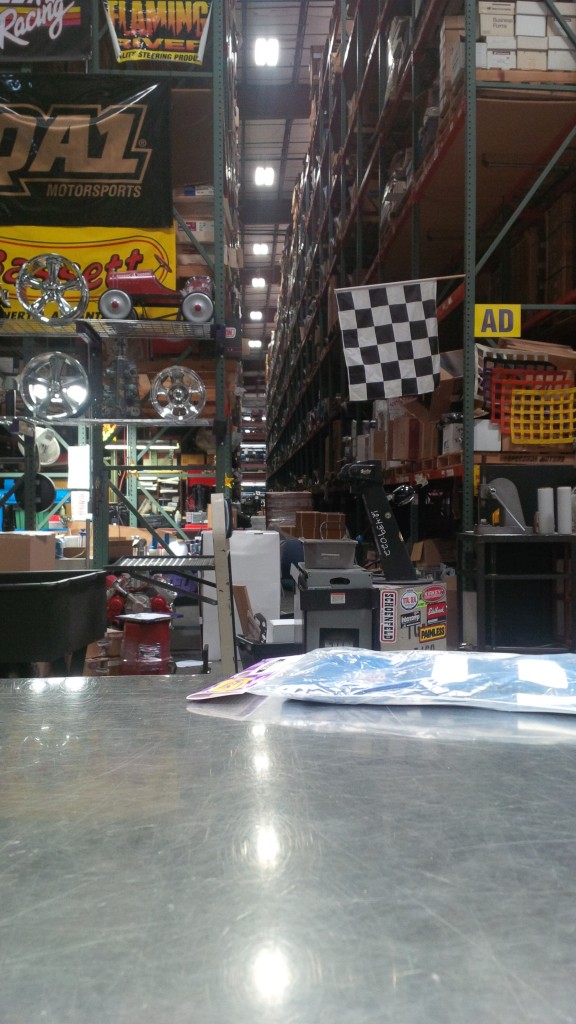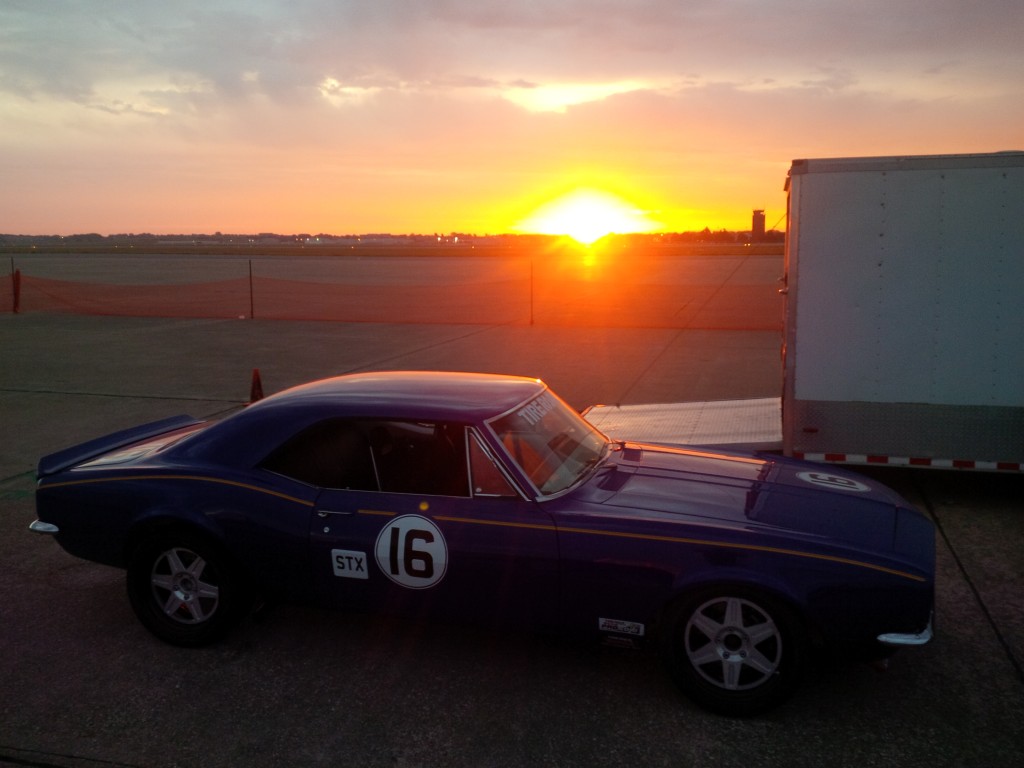2013 year-end recap, status, and look forward
Interesting timing, it was 3 years ago today I bought the Camaro. Even though it took a long time to get the car together and out to an autocross, there was a lot of frantic work there in the middle. 2.5 years is a pretty quick pace for a frame-off restoration, especially when you consider some of the special race fabrication elements that went into it.
Finally feel like I can relax a bit. In the garage sits my dream car – sure, there are things more expensive, or exotic, but this is the car I’d rather have than any other. And there’s still lots to do to make it better!
Let’s take stock of there things are now, starting with a more detailed rundown of how Nationals went, now that I’ve had a chance to look through the data.
{Nats Day 1 – EAST COURSE}
The below is a screen grab of the Motec data analysis software – still learning it, this is really the first time I’ve used it. Here I’m displaying pretty much all the values I’m recording, with my first east course run (with no time) as the Main [M] run, and the run I ended up standing on, as the Overlay [O] run. The Race-Technology software I’m used to allows you to overlay 4 or 5 runs simultaneously which is great for autocrossers, but the Motec software (at least the i2 Standard version I’m using, the “Pro” version is a $500+ upgrade) only allow for two.
What do we see here? A few things, some encouraging, some a little concerning. Let’s start with the positive-
The class winner Jeff Hurst ran a 78.2 on this course. My best scored run was a 79.9. But in actuality, my first run, which had a timer error, was a 79.3, 6 tenths faster. That first run started out slow, but from roughly the 20-second mark through to the finish, my first run was a full one second faster than my second timed run, the one I’d stand on.
This sounds very woulda-coulda-shoulda, but the point is, the car as it was then had at least a 78.9 in it with me driving, and likely a bit more if the course were chopped up into a bit finer pieces. With an even better, who knows…I didn’t drive my best, and am not a pro; seems like somebody really good could have done a 78.2.
The concerning things-
1. Why was the car so much faster on its first run? Well, I spun on the second, which made me extra-cautious in the braking zones of later runs, which shows in the data. Another thing is, the pushrod let go either on that run, or the one where I spun; sometime on that spin run is where I noticed the noise, which heavily distracted on the third and fourth runs. Also, maybe the tires were too warm? Was a single driver on Dunlops, but it was warm out, and the car is a bit heavy, maybe they got over-temp?
2. Oil pressure. The car has a high-end Milodon roadrace oil pan, with three trap doors, dual lateral kick-outs, and it all fits perfectly in a just-barely-enough-room sort of way. But if you look at the oil pressure graph, you can see it drops at times, sometimes into the teens (low of 14!) – and those drops correspond with braking events. The harder and more extended the braking, the more the oil pressure drops. In researching this, some have had this happen when the pickup comes loose from the pump; while that’s possible here, I don’t see it as too likely. More likely there’s too much oil up in the heads and whatnot, the pickup is getting slightly uncovered under braking.
I added a bunch of oil for day 2, but the West course had fewer, shorter, and lighter braking zones, so it’s hard to tell if doing so helped any.
{Nats Day 2- WEST COURSE}
On this course, the story is overall less optimistic. This was more of a handling course, not the sort of place I would expect to do comparatively well on. Here, the class winner Hurst ran a 56.3; my best was again the first run, with a 59.2 – 3 seconds back. My third run was a dirty 58.6, which is still about 2 seconds back. Examining some sector times from this course shows I probably could have done a 58.1 if my own stars aligned, so a 57.x with a better driver in it. Still quite a ways off. The only thing that helps, is that I know my head wasn’t really in it this day, and a really good driver probably could have found a lot more time than I was able to.
###
General observations from the data-
Looking at lateral acceleration – this is something I’m used to seeing from the DL1 in the 240sx and Viper days. I remember the trip to Heartland Park Topeka in 2006, the first time we ran Nationals there. Upon arrival, the 240sx was “only” good for about 1.05g in a corner, but as the surface got better, it was doing 1.25 during Nationals competition. That was on asphalt.
The Camaro is making quite a bit less grip than this, even though the surface is better at Lincoln. The data presented above is smoothed over 3 samples where is says f3 (so 3/25ths of a second average), and while it shows spikes around 1.25 in each direction, the more heavily smoothed values over the course of a corner are mostly right at 1.0. While I haven’t seen others’ STX data yet, I would bet the RX8, FRS, and BMW are making 1.2+ where I am only making 1.0. That matters A LOT.
Longitudinal acceleration is a bit happier tale 🙂
Exiting the last big left-hand sweeper on the West course, the car goes from 35 to 55mph in exactly 2 seconds, even though there was some lateral acceleration in there to create drag. In other places, longitudinal spikes over .6 when lateral is minimized. When the car was running right, it was pulling quite strong.
Below is a g-g diagram showing the car’s “performance envelope” as it existed on its first east course run.
For comparison, below is a similar chart (from different software) from an STR MX5 at a BFG Rival vs. Dunlop Direzza Z2 tire test earlier in the year, on crummy asphalt (San Diego’ Qualcomm stadium southeast lot):
Note how the “top” of the MX5’s envelope seems so flat – that’s the car spending a good bit of time at its power limit, even on a poor surface. In comparison, the more powerful Camaro’s is more oval-shaped, showing how it is able to work the tires to their limit in all directions.
“Okay, all that data was tl;dr, what did I miss?”
1. The car would have trophied if I just drove better.
2. With a superhero at the wheel, it might have got a top 10 (at least 2.3 lower total time)
3. A win (4.6 lower total time) was waaay out of reach.
Why was the car not competitive for a win in STX?
Will get to why that’s a past-tense question in a bit. But here’s the reasons, with the biggest ones first:
1. The car is not producing enough peak lateral grip, and it is difficult to maintain the limit it does have
2. On equal-height f:r tires, there is still too much rearward brake bias, making the car difficult to trail-brake
3. The valvetrain has not been reliable and is costing time either as lost power, a distraction, or both
What can be done about it?
Here’s what the car needs for its ST future. Start by addressing the lateral grip problem with:
1. Ride height changes.
The car is too damn high! I know this was just posted, but look at it again, and look at all the daylight you can see *under* the front splitter.
In the front, the car has yet to bottom out, even over the big bump we had at Farmington. Lowering the front will make a big difference on CG height, and even helps the camber curve. To get the car lower I’ll have to cut the springs a bit which will up spring rate, but that is probably ok, the car is still a bit loose, and I can back off on front swaybar stiffness if needed. Not sure how much lower it can go – probably at least 1/2″, maybe 1″. Will start to look a little funny with the tire tucked up in there so far, but that’s not important!
In the rear, the car was raised about 1.25″ before the start of the Pro Finale, spacer blocks removed to combat the axle-moving-all-over problem. The rear needs to be brought down at least that much, if not more; it too wasn’t bottoming at Farmington over the jump, can maybe go 2″ here.
Unfortunately this isn’t just a shorter spring or twisting a spring perch – this is going to require complete re-engineering of the rear end. In order to retain the leafs and good axle location, the springs will have to be run below the watts link plate on the driver side, which will necessitate fabricating some kind of extended perch to hold the spring.
If the CG can be lowered 1.5″, I believe that’s close to 10%, meaning 10% less load transfer, which I’m optimistically hoping is 5-7% more lateral grip potential, changing the 1.0g to 1.05 or 1.07. Those numbers are all very optimistic, half that is more realistic.
2. Spring wind-up was a problem, not just in first gear at launch, but also under heavy roll-on throttle in second gear. That wind-up makes for annoying hop when going straight, but in a corner, it feels like it works to jeopardize grip. The solution then is a setup that controls torque reaction better than just the leaf springs, while not introducing bind or other undesirable handling characteristics. Torque arms are such devices, as are 3-links.
3. Overall the rear of the car felt not compliant enough. Even though the ride frequency and static weight is much lower than the front, the rear tires were much hotter when coming in from a run than the fronts (and this wasn’t caused entirely by overzealous throttle). Rear suspension compliance will be addressed in a number of ways simultaneously.
3a. First is to have the rear shocks revalved with less bump damping. Even though these have the fancy regressive curves, they’re valved too stiffly; basically, they are at the soft end of what was run on a heavy, race-tired, FWD, roadrace car…a place where you can get away with a lot more bump damping than a street tired RWD dinosaur. Will probably have the new baseline be half to 1/3 the current bump values.
3b. Next will be addressing the bushing situation on the front leafs, perhaps in conjunction with #2 above. Right now the leaf springs have to twist as the suspension moves, and that twisting is another spring effect in roll. If the setup could allow for the springs to have to twist less, or to lessen the bushing resistance to that twist, it should make the rear more compliant.
This lack of compliance I feel is driving the need for a lot of the steering corrections you see me make, and even on the relatively smooth Lincoln surface, contribute to a loss of time. The 1:15 mark of this East course video is indicative; instead of a nice run into the slalom, the rear end gets bounced, and I have to give up any chance to accelerate further-
Improving the compliance should up the limits a little further, and making holding the limit easier over surface imperfections.
4. The rear roll center is probably still too high. This will be mitigated somewhat when I lower the rear of the car, as the watts center pivot is based off chassis height. At Nationals this year I had a chance to speak to both Mike Maier and Mark Madarash, two of the very best drivers and tuners of live axle RWD autocross cars on the planet. While I generally prefer to figure things out on my own, I couldn’t overlook that after peeking under the back of the car they both (in separate conversations on different days) very quickly told me the rear RC was probably too high, and that a height closer to the bottom of the diff (maybe 4-5″ lower than it is at present) is a place they’ve found to work well. The current watts arrangement is a bit against my own ethos, in that I don’t like having an adjustable component always at the edge of its adjustment range, especially if adjusting “more” in that direction could be helpful. I’ve got it as low as possible, but clearly, lower still is worth investigating, even after I bring the chassis down.
That means going back to a customized rear axle lateral locating device…either an altered watts center frame, going back to a panhard, or even looking seriously at a Mumford link. All of these choices mean welding, which probably means pulling the gas tank…all of this, a big project. One that should probably be tackled in conjunction with the axle torque management project of #2.
5. More basic tuning. Still in the early days of looking at photos of the car from Nationals, to see how the outside tires look when loaded up. Have more learning to do about pressures, and have yet to scientifically take temps. I am curious to try the car with a bit less static negative camber (around -6.5 at present) but more caster, to see if that allows for better use of the inside front. Made the first rear shock change, adding a little bit of rear rebound after the ProSolo. I think things could be better with even more rear rebound, but I need to be able to soften bump (already at full soft) and do other things to increase rear end compliance, before trying it.
Instability under braking is perhaps a bit easier, and should be made better simply by switching back to the 1″ taller 40-series rear tires. As Dunlop doesn’t make a 265/40-18, that means Hankook. Given how heavy the car is and how effortlessly it generated heat in the rear tires, this should be ok. To some extent the taller sidewall should also help with rear end compliance over bumps, with the taller sidewall functioning as a slightly taller and softer spring. Unfortunately this runs counter to the CG height lowering efforts but I think will have a very positive effect on overall driveability.
The Valvetrain is due for a thorough inspection, and some other changes to work it a bit less hard. It’s possible the occasional low oil pressure condition is a contributing factor, but I tend to believe it’s a high RPM thing. The rev limiter was lowered to 6900 for Nationals, which was barely enough really. Going to the taller rear tire will add about 2.5mph of top end, and the other change I’m considering is going from a 4.88 final drive, to an only-slightly-less-insane 4.56. Together these would bring 2nd gear’s speed limit to 70, from just under 63mph now. Unfortunately these changes would also reduce the potential 2nd gear thrust by about 10%, but if it meant the throttle was easier to use, might not be so bad, as I spend so little time matted today anyway.
To test the valvesprings to ensure they’re still ok and not cracked means pulling the heads, which probably means pulling the motor, which would also give a chance to review the dinged #2 cylinder from the compression test oopsie. Ugg, another big project. That one can probably wait a bit though.
##
All of those changes added up, I think will make a significant difference in the car’s ultimate potential, and in its driveability. It is difficult to predict a time quantity, but my feeling is the above changes, with another year of practice, makes the car a solid trophy-capable STX car at Nationals. As it was, the car earned a trophy at the ProSolo Finale, which has a generally more die-hard group of competitors than the regular Solo Championships. At the ProSolo the planets of favorable courses, favorable conditions, and halfway decent (for me) driving aligned to benefit the car so early in its development. Another year of tuning and advancement would be seriously beneficial to a car that has now only run 5 events.
Unfortunately
I was lucky to get that trophy because it looks like the days of this Camaro, or any Camaro, in STX are over. The SEB (Solo Events Board) have recommended to the BOD (SCCA’s Board of Directors) to move all ponycars (GM’s F-bodies, and the Ford Mustangs) to the STU class, at the behest of the membership.
As a bit of background, there are a lot of folks with newer Mustangs, especially the 400+hp 5.0 Coyote model, that would like a better place to run in ST, than STX. Their cars start out over 3500 pounds, which is a lot to make work on STX’s 265mm tire, 9″ wheel limit, even after working hard to get the weight in the low-to-mid 33xx’s.
They figured with the unlimited width wheels and 285mm tires in STU, the cars would be much better, and asked to be moved there.
Certainly, I think pretty much all of the ponycars (with the possible exception of the early Mustangs, which nobody runs in ST) can benefit from tires wider than 265, and wheels wider than 9″. The immediate problem though, is STU is generally a much faster class than STX – it is the place of the Mitsubishi Evo and the BMW M3.
As far off of the STX winner as I was, the STU winner was a full three seconds ahead of that. As undertired as the ponycars are, it is difficult to see how 20mm of otherwise identical tire, and 1-2″ of wheel width, are worth 3 seconds over the 2 days.
To make matters worse, in conjunction with the move of ponycars to STU, the C5 Corvette (non-Z06) is also being suggested for STU inclusion.
Without going through the entire Comparative Vehicle Dynamics series I authored, suffice it to say, the ponycars have no chance against a C5 in anything resembling an autocross. There is simply no point running against a C5 in a Camaro, Mustang, or Firebird. Something like an E36 M3 can pray for a course of nothing but slaloms, and the Evo/Sti boost buggies still have advantages in launch, early corner exit, and inclement conditions; enough to keep them in it for a while.
What I hope to see happen is rapid realization of this fact in the ponycar community, and a show of unity and support for the notion of a ponycar-specific ST class. Today, the only remaining successful Street Prepared category class is ESP – the one catering to ponycars – and if an equivalent ST class were available, I think it could be a good success for the category, the club, and the membership. In addition, it would provide a more appropriate place for me to run the Camaro.
Where does it go from here?
The path forward is not clear. One thing for certain, is I am not going to run it in STU against the C5. San Diego is just too far from Lincoln for that kind of nonsense. The car’s continued participation in the Street Touring category hinges upon it either being kept in STX, or included in “STP” – what I hope will eventually be an ST category class for Mustangs, Camaros, Firebirds, Chargers, Challengers. I’d like to see it keep the older and lighter stuff on smaller wheels/tires, and allow the heavier/newer stuff more. If the class is built to make a newer Coyote 5.0 Mustang the “Car to Have”, its numbers should be very good. I’d also love to see the SCCA work to allow certain Pro-Touring cars into this class so long as they started off as an allowed car and then met certain weight and size requirements.
So, if the SEB’s suggestions go through, the car will be sitting it out in 2014. There are some Pro-Touring type events I’d like to run, maybe a local event or something. Willing to keep the car tucked away for a while and see whether there is interest in the STP concept, for which I would bring it back out to support. Gives me more time to get some things done on it at a relaxed pace. The past 3 years building the car, I always had the feeling time was running out on STX as it had existed since 2004, and I got it done just enough, just in time, to snag a trophy in Lincoln.
If the worst happens and there is no future for the car in ST, then some years down the road I may consider making it into an even truer Penske/Donohue clone in CP trim. I’d probably try the light and narrow approach, 10″ wheels and and under 5.1 motor @2700lbs. But I really don’t want to think about that too much, because it means redoing almost everything, and turning the car into a kind of monster I’m just not that interested in right now. Really hoping we can find a way to make STP work.
Signing off for now,
J-Rho
2013 National Championships
Well, that was about what I expected…
After a better-than-expected finish at the ProSolo Finale the weekend before, had high hopes headed into the Solo National Championships.
At the Pro the car finished 5th, ahead of some car/driver combinations I had no business being ahead of. Some of it was a course that favored the car, some of it was in the problems those car/driver combos had. The Camaro at this point is rather tricky to drive – I don’t yet have a good feel for the brakes, am still learning the requisite throttle control, and overall, the car is much less forgiving than it could be. With 6 tries at each course in the Pro, it gives me the chance to learn the correct braking and throttle application points by experience, vs. going by feel or judgment. Worked there, but you don’t really get those chances in the Solo…
The Pro ended on a Sunday, and STX didn’t run until Thursday/Friday. This gave three days to further test and tune the car, and I had time slots Monday, Tuesday, and Wednesday.
Monday’s slot was used to test a shock change, with everything else from the Pro totally left alone. Up to that point, the car had always felt very “dead” in slaloms. At the car’s very first event, I’d turned the shocks from an unknown initial setting (which turned out to be full stiff) to full soft in all 4 adjustments (rear shock description). In general in a powerful RWD car I like the rear shocks set a little softer than you might want for ultimate pure-handling performance, as it makes the car a little more forgiving of incorrect throttle or brake inputs. And the car was so deadly loose early on, full soft made sense.
As the grip in Lincoln was very high and my comfort level with the car was rising, the first real shock change I did, was to take rear rebound from full soft, up to about 25% stiff in its adjustment range. The car responded very well in the slalom on the test ‘n tune course, really starting to come alive in those transitions. “More” might have been better but that was a start, and I didn’t want to overshoot and make the thing a nightmare.
Monday I was approached by the GRM crew, they were interested in doing a shoot with the car. Even at 6:30pm it was still a little bright out to do engine bay shots, thankfully Tom McDaniel was there to lend a hand, and some big sign thing, to help them out.
Tuesday test ‘n tune covered the switch from the Hankook RS3 tires to Dunlop Direzza Z2. As we were running in the first group in the morning, which would be relatively cool, and I had no codriver, I felt this was a more appropriate choice given the likely difficulty I’d have in getting (and maintaining) enough heat in the Hankooks.
The Dunlops were on the new CCW “Classic-5” wheels in 18×9. These wheels have a very nice vintage look, and since they were made with quite a bit less backspace, they can be run without spacers, while providing a much more aggressive “deep dish” sort of look. From before:
Unfortunately the car had a bit of a rubbing problem in the front with the wheels at this backspace. A little bit of rubbing is ok, but I was worried not just about damage, but about what sort of funky understeer moments this extra “brake” on the outside front tire might cause. Cut this session short with 2 runs, and had a pair of the Dunlops mounted on the higher-backspace Jongbloed wheels.
Wednesday’s test session had the new front wheel setup, and I also changed out to my lightweight “Nationals” battery. In the picture below, it’s the one on the left-
It’s an XS Power C680, which is the same form factor as the Odyssey PC680. It’s shown next to the Odyssey PC1200 I’d been running. The lithium battery is crazy light – under 4 pounds. When you pick it up, you’d swear it had to be an empty battery case. This switch saves 35 pounds, and since the car burns fuel so fast, it was probably under 2950 competition weight for most runs.
Speaking of fuel, this thing drinks it up! The tank was nearly empty on the trip out, and I decided to do most runs with the tank full (note the signs of fuel having sloshed out the back in the battery picture above) – and on this trip, the car got over 27 gallons put in…but I think the stock tank is only 18 gallons. Major thirst!
Here is video of my second test ‘n tune run Wednesday:
Was pretty happy with the way the car was working here – again, I’d had several chances to learn the braking points, and how the car was going to behave in each section. This was a 31.1, which wasn’t far off the times I was hearing from the other STX and STR guys – mostly 30.6-30.8.
One other thing I got going Wednesday were some more features of the car’s Motec dash unit. It features a full data logger with 3-axis accelerometers, and I’d also purchased the GPS option. Hadn’t got the time to get it working previously, but thanks to good support from Jeff Feit at Optimum Motorsports was able to figure the last bit out, GPS and data logging all set for the big race.
Thursday was a nice warm morning, thankfully the price we paid in suffering the heat, meant this was a Nationals where rain wasn’t a totally devastating factor for some people (my ninth trip, first time that’s been the case).
First run out felt pretty good on Sam Strano’s east course. Car was running strong..missed some spots and broke way too early in others (including the showcase turn) but a decent first run. Unfortunately when I came in, there was no time!
Turns out that happened to about 8-9 of us. No big deal, I’ll take another free shot at things…
Second run started out better, but not wanting to brake too early or too lightly, I spun the car under braking after the slalom after the showcase turn. Didn’t think my inputs were that worthy of a spin, but there was the rear rebound change, plus the bias had been shifted with the move to equal-diameter rear tires. Bummer, so my first run with a time, is a throw-away.
My “real” second run was an improvement, but still about 2 seconds off where the leaders were running. I was being very careful on the brakes, using them waaaaay too early into the showcase turn, a mistake I saw lots of people making.
Here’s the video – note the head-shake in the middle of the showcase turn (around the :20 mark)
Another thing to note in the video, is what sounds like the rev limiter as the car heads out in first gear. There are a couple other places where it does the same thing in second gear.
While driving, I thought it was the rev limiter, and was surprised how fast the course was; even with the shorter tires and lower rev limit, the car was good for mid 60’s mph in second. Gary Thomason was watching and said it sounded like things were “breaking up” at high RPM, like maybe the ignition was failing, or the valved weren’t adjusted properly. They had been adjusted recently, hmmm. It wasn’t doing that on my first run, but definitely was now, and it was throwing me off a bit, as it was a distracting sound. The one or two times I had a chance to look down as it occurred, the tach was around 6k, not near 7k where the limiter sits (6900).
Third run felt about the same as the second, and was a little bit slower. Something definitely wrong at high RPM.
Much later that day after the engine had cooled, went to adjust valves. The first few were ok, then I got to the #2 intake valve, and found it very very loose. So I tightened it, and it still seemed loose. Then I noticed bits of metal sitting there next to the valvespring. Uh oh. The rocker looked ok from the top…
But not from the bottom. Those bits of metal must have worked their way between the rocker arm tip and valvestem top at some point, causing this damage to the rocker. Fortunately the valve looked ok. The pushrod, on the other hand-
Not so good. Somehow the tip completely went to pieces. Not sure exactly how it happened, but this was certainly contributing to the high-rpm stutter the car had been displaying.
Fortunately Speedway saved my butt yet again, with a box of fresh pushrods. I don’t know in how many towns you can find a place with stock SBC pushrods in stock at 5:30pm on a Thursday night, but I am thankful Lincoln is one of them.
Got back to the site and replaced all 16 pushrods just to be safe, inspecting the old ones, and all the rockers in the process. Fortunately everything else looked fine, no apparent collateral damage.
Was a little tired by the time this work was completed but the car started up and sounded fine in the trailer at 9pm.
…
Friday started earlier, so it was cooler, still dry. I was in high 20-somthing-th place, but that didn’t feel too bad. The car hadn’t been running right the day before, and 2 seconds on a 75+ second course isn’t *that* bad for the car’s first trip out…I could try to close the gap a bit today, maybe move up into the trophies?
Alas, it was not to be. Friday we ran Elliot Spiedell’s West course, which was much more a classical handling/speed-maintenance course (though to be fair there were a few little acceleration spots). Here is my first run, which ended up being the run I’d stand on:
My head wasn’t really in it, and to make matters worse, the car was apparently smoking badly on course. Visual inspection showed the passenger valve cover leaking at the back, oil making its way onto the header. This made sense, as I’d had them off the night before, and maybe didn’t tighten that one enough, or perhaps the gasket didn’t seal.
That was an unwanted distraction from what should have been spent figuring out where and how to go faster. Second run was better in spots, but mistakes in others, working out to almost exactly the same time, plus a cone. Apparently the car was smoking even more now.
Found an allen wrench and tried the only thing I really could with everything super hot – tightening the valve cover.
Unfortunately that did what tightening in these circumstances normally does – it made it worse. I don’t have any good pics yet but apparently on its third run, the car was a James Bond smoke-screen in full effect.
Realizing I was pretty much out of it at this point I pushed the car a little harder on the third run – taking those chances netted two cones – but the raw time was still over 2 seconds off the leader, on a 56-58 second course…which felt much worse than the 2 seconds on a high 70 second course. Partly because the % gap from the lead, but also because the car seemed to be running fine. A bummer result, to never really feel “in the hunt” for a trophy, much less the win. Ended up 29th of 59.
…
What is plaguing the valvetrain? Besides the engine troubles, why was the car so slow? What does the data say? Where do we go from here?
Wasn’t this update long enough? We’ll get to that next time… 🙂
2013 ProSolo Finale
The 2013 ProSolo Finale is in the books, and by most accounts it was a success!
In SCCA autocross there are two series of events run in parallel – “regular” Solo competition consists of 3 runs taken on a given course, where there is usually a sharp turn before the clock starts, to eliminate a launch advantage. Big events last 2 days, with the course run one direction on day 1, and the other direction on day 2, with the lowest sum time winning. For the Solo National Championships, instead of running the same course different directions, you run two separate courses.
“ProSolo” consists of two courses set up in mirror-image, with competitors lined up side-by-side. Between them is a drag tree, which brings the driver’s reaction time, ability to stage the car, and their skill in launching from a dead stop, into play. In ProSolo the drivers get to run each course six times for a total of 12 runs – each course twice Saturday morning, Saturday afternoon, then Sunday morning.
ProSolo is a lot of fun, and the back-to-back runs can be pretty intense.
The week of National Championships in Lincoln Nebraska starts with the ProSolo Finale – the last event in the ProSolo series – there are winners for that event by itself, but since ProSolo has points, it also determines who is the year-end class champion. After the Finale, the regular Solo National Championships are run – half of the people run on Tuesday/Wednesday, the other half Thursday/Friday – there are over 1200 entrants so it takes 4 days!
For me this year, the ProSolo Finale was mainly a big test and tune event to make sure the car is ready, and the driver is warmed up for the Solo National Championships I’ll be running Thursday/Friday.
Having successfully completed the Pre-Nats Thrash of the previous post, got the car out to Lincoln with a long but smooth two-day trip. Unloaded the car and took these photos – the wheels are CCW Classic-5’s – 18×9, with a lot less backspace than the Jongbloed’s I’d been running. The CCWs are a bit heavier but have a nice vintage look.
I’d signed up to run the Test ‘n Tune the Friday before the ProSolo just to make sure everything was ok and to get warmed up. It was blisteringly hot that day (over 100) which made doing anything a chore. At the test ‘n tune, on the first run, the car wasn’t running right. I suspected it might be some intake tricks I’d tried, so I drove back to the paddock and undid the tricks, trying not to burn myself. Back at the test ‘n tune waiting to do my second run, the car stumbled a bit, then shut off!
That seemed strange to me, and the way it died in a not-so-sudden way, more of a stumbling death, made me think it might be fuel. In building the car I goofed and didn’t connect the fuel gauge sending wire, so I have no gas gauge – it’d been totally full for the San Diego Tour earlier in the year, but I hadn’t added any since. The Camaro holds 18 gallons, which means that with Sunday morning runs at El Toro, the Farmington ProSolo, and a few other miles of miscellaneous putting around and idling, the car burned 18 gallons!
Fortunately the fix here was easy – add gas! 5 gallons in and it was good to go for my second test ‘n tune run.
On this run, something else bad was happening – there was a bad cycling rubbing sound coming from the left rear. I’d been interested in how things looked back there, so I had the camera watching the left rear from the outside. Sure enough, upon review, the axle was moving all over the place! Big lateral deflection, combined with axle tramp, made the rear axle look totally out of control. Somehow I’d been able to get away with this setup before…maybe it was the grip from these new-gen tires on concrete, maybe it was fatigue in the U-bolts holding the big sandwich together, not sure…but in any case, it was very not happy.
To combat this, I skipped the last two tuning runs, and headed back to the pits to get to work on the car. Wanted to remove the big spacer blocks from the equation. Since the axle perches expect a multi-leaf spring pack, and I’m running a single composite leaf, would need *some* spacer block. Fortunately, the central warehouse for Speedway Motors is here in Lincoln Nebraska, only a couple miles from the event site
From their huuuuuge warehouse, was able to get 1/4″ and 1/2″ spring spacer blocks, and the 1/2″ turned out to be perfect – it snugged the plate for the driver-side watts link connection right up to the welded-on spring perch, reducing the leverage these parts had on each other significantly.
Saturday morning for the first set of runs I was rather apprehensive. It was very hot out (already in the 90’s), and the car had two failed test ‘n tune runs the previous day, and no testing on the new setup. To my delight, things went well. The car completed its Saturday morning runs without issue – though I did happen to spin on my last run. Times were quite a ways off the pace (about 1 second per side) but I was putting a lot of attention into the car – wanting to be sure it was running properly and healthy, and that nothing was rubbing or coming apart – instead of focusing on driving and hitting my marks.
Saturday afternoon was a bit of an improvement, even though it was extremely hot (100+) when we ran. For this session I moved the camera under the fuel tank to watch what the axle was doing at the left rear:
Interesting to watch – lots happening under there in an autocross run. Water temp was about 215 when I finished but all systems (cooling, power steering, charging, etc.) seemed to be taking it fine.
I wanted to adjust the valves Saturday evening before it got dark out, but doing so requires a cold engine – even after sitting for 2.5 hours after my Saturday afternoon runs, most of the engine was too hot to touch, so it was put off to Sunday morning.
Sunday arrived at the site a bit early to do the valve adjustment. Turns out the new rocker arms and balls wore-in quite a bit, and gotten far out of adjustment. That was costing the car some power and could impact reliability, so I was very thorough in getting everything adjusted properly.
Sunday morning’s runs were better – it was cooler, the cornering grip levels had come up, and I was feeling more confident in the car holding together, allowing me to focus on driving. Ended up dropping enough time to move into 5th place – with 15 drivers, good enough for the last trophy spot! Pretty satisfying to get a trophy at only the car’s 4th event ever, against some very skilled drivers in “proper” cars.
Overshadowing the excitement of that result, is how still very far back I was from class winner Bryan Heitkotter’s times. Bryan couldn’t get his Nissan 300ZX prepared in time for the Championships this year, with a silly excuse, having been called by Nissan to run a GT3 GTR at Infineon, over the last weekend he had to prepare the car. So instead he ran Charlie Davis’s E36 BMW, the car he won Nationals in last year, a well prepared car he’s very familiar with, and fast in. Bryan is running a different class for the Solo Nationals so he won’t be a worry there, though the class won’t have the same weight without him in it – for our measly entry fees, we get to run heads up against professional race car drivers! Pretty fun aspect of SCCA autocross.
Between now and Thursday, need to figure out how I can go .6 seconds faster per 50 seconds of course – which was about the gap from me to the second-fastest STX car, since Bryan is out. Some of that may come from driving, some from further tuning. Will be a busy next few days for sure!
Here is a high resolution video of my best two runs from the ProSolo.
